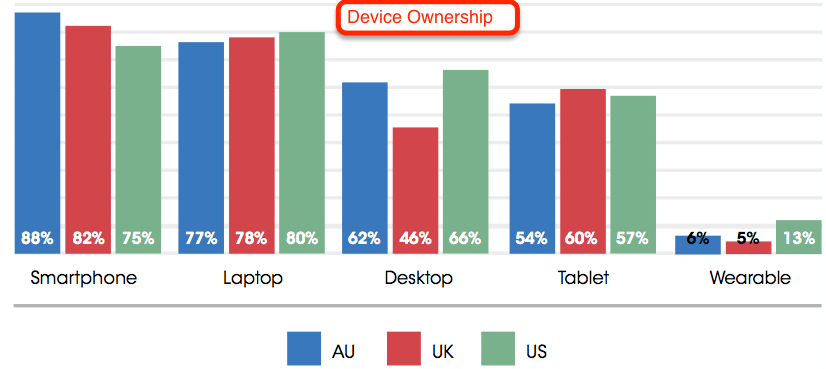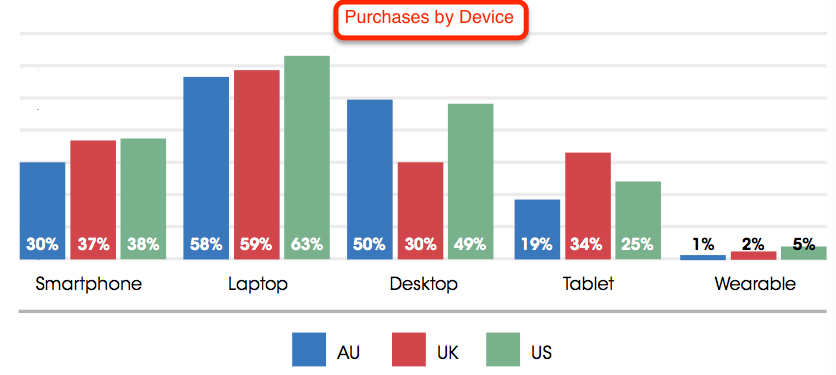Consumer technology is constantly evolving, reshaping the way retailers and consumers interact on a daily basis. These changes force retailers to provide functionality that allows consumers to easily make purchases on their device, or devices, of choice. It’s become critical to understand how devices are used in different ways from one region to another.
Looking at results from a recent Bronto-commissioned survey of adult populations in the UK, US and Australia with access to a laptop, desktop, tablet, smartphone or wearable, the device of choice and shopping patterns change, not surprisingly, based on demographics and locale. So what does this tell us about how retailers need to prepare for shifts in consumer purchasing behavior?
Location, Location, Location
Smartphone adoption, to no one’s surprise, is at 75% or greater in the United States, Australia, and the United Kingdom, with Australia leading the way at 88% adoption. However, the UK appears to be leading the way in terms of ditching their reliance on desktops and laptops in favor of mobile devices. Desktop ownership is significantly lower than both the US and Australia, and the country has the highest tablet ownership of the three.
Does Buying Behavior Match?
In the US and the UK, 60% of respondents have used multiple devices to complete a purchase, while only 35% of Australians have done so. While this may signify a smoother purchase process regardless of device in Australia, we see a lower overall adoption of purchasing via mobile device in Australia. This leads me to believe that consumers are less comfortable making mobile purchases in AU, while UK and US consumers are still struggling to find a seamless, one-device experience. In those regions, it may be that the purchase process on mobile devices is still not fluid enough for consumers to complete the purchase on their device, causing them to abandon and later complete the purchase on a second device, likely a laptop or desktop.
In the US and AU, desktops and laptops remain the most common devices for purchasing, while in the UK, laptops and smartphones are the most common methods. When looking specifically at mobile devices, smartphone purchasing is fairly even between the US and UK, but tablet purchasing is significantly higher in the UK than in the US or AU.
What’s the DNA of Who’s Buying?
It is not surprising that the younger the demographic, the more comfortable they are shopping via smartphones. Younger consumers in the US appear to be most comfortable making purchases via smartphone, with the UK and AU following respectively. However, the US begins to see the noticeable drop with the 45-54 group (from 58% to 31%), while the AU and UK see the decline with those ages 35-44. While US consumers under the age of 54 are more comfortable using smartphones for purchases, they are still not ready to ditch the more traditional methods.
When it comes to gender differences, we see men owning slightly more devices than women in all three countries. However, when it comes to smartphone purchases, the AU and UK are dead even with 37% of men and women making purchases via smartphones. Surprisingly, we see a significant disparity in the US, with 43% of men making smartphone purchases versus only 35% of women.
Take Two Tablets and Call Me in the Morning
In the UK and AU, the 25-34 year-old demographic leads the way with regards to tablet purchases, while in the US, it’s those 35-44. Overall, this is not entirely a surprise, considering the low desktop ownership in the UK. But it may indicate that, in the UK, tablets have successfully replaced desktops in the home and thus generated a greater share of those purchases.
Final Thoughts
Purchasing with a mobile device is fast becoming the norm, and streamlining the online purchase process will be essential to provide your customers the experience they expect. Here are a few ways to ensure a smoother consumer experience:
Focus on mobile first. Mobile devices are constantly becoming more powerful and are fully embedded into everyday life. Assume this, or another mobile device, will be the primary form of engagement now and in the future. Be sure your emails are mobile-friendly and your website provides a great mobile experience.
Make it easy to purchase. Having a mobile-friendly site does not mean you have optimized your purchase process. You must streamline the checkout process and reduce obstacles to conversion. Consider promoting account creation in your email messaging when acquiring new email subscribers to support a smooth checkout process.
We know that consumers expect a consistent omnichannel experience, but delivering it in a manner your audience expects will be critical in order to maximize revenue and create long-lasting customer loyalty.
Greg Zackowicz is Senior Commerce Marketing Analyst for Bronto Software


